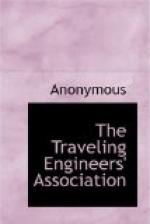63. Q. Is the engineer responsible for the fireman’s conduct while on duty and for the manner in which the fireman’s duties are performed?
A. He is. The fireman is under the direction of the engineer, and the fireman’s duties are to be performed in accordance with the engineer’s instructions.
64. Q. What is the duty of the superheater damper, and how does it operate?
A. The duty of the damper is to control the flow of gases through the large flues, thereby protecting the units which are contained therein from being overheated after throttle is closed. The position of damper when the engine is not working steam, is closed.
65. Q. What will be the effect on the steaming of the engine if the damper does not open properly?
A. Engine will steam poorly for the reason that there will be no draft through the large flues. The steam will not be superheated because heated gases cannot come in contact with superheated units contained in the large flues.
66. Q. How may steam failure be avoided in case the damper fails to operate?
A. The counterweight may be tied up, thereby opening the damper.
=Air brake questions=
1. Q. What is an air brake?
A. A brake operated by compressed air.
2. Q. How is this air compressed?
A. By an air compressor on the locomotive.
3. Q. Name the different parts of the air brake as applied to the locomotive.
A. The air compressor, compressor governor, automatic and independent brake valves, distributing valve, triple valve, auxiliary reservoir, brake cylinders, main reservoir, air gauges, angle cocks, cut-out cocks and the necessary piping.
4. Q. What is the purpose of the main reservoir?
A. It is used for storing a large volume of air for the purpose of promptly charging and recharging the brakes. Where the engine is equipped with either the E. T. or L. T. type of brakes, main reservoir air is used to supply the air to the brake cylinders on the locomotive.
5. Q. What other appliances use main reservoir air?
A. It is used in the operation of the power reverse gear, sand blower, bell ringer, water scoop, air signal, fire door, water sprinkler and other devices.
6. Q. What does the red hand on each of the air gauges indicate?
A. The red hand on the large gauge indicates main reservoir pressure; on the small gauge, brake cylinder pressure.
7. Q. What does the black hand on each of the air gauges indicate?
A. The black hand on the large gauge indicates the equalizing reservoir pressure; on the small gauge, brake pipe pressure.
8. Q. What pressure is usually carried in the main reservoir?
A. Ninety pounds in freight and 130 pounds in passenger service. But where freight engines are equipped with duplex compressor governor, the low pressure top is adjusted to ninety pounds and the high pressure top to 130 pounds.




